Sarkar N. (ed.) Human-Robot Interaction
Подождите немного. Документ загружается.

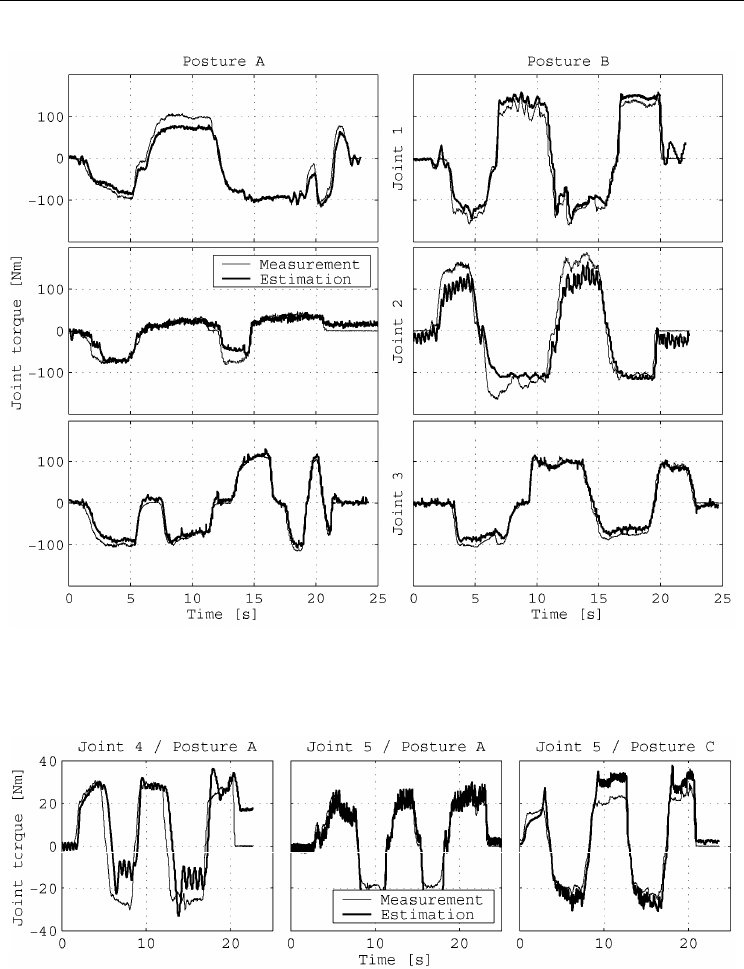
Possibilities of force based interaction with robot manipulators
461
Figure 12. Comparison between interaction torques estimated from motor currents and
values measured by F/T sensor at different postures of the manipulator arm
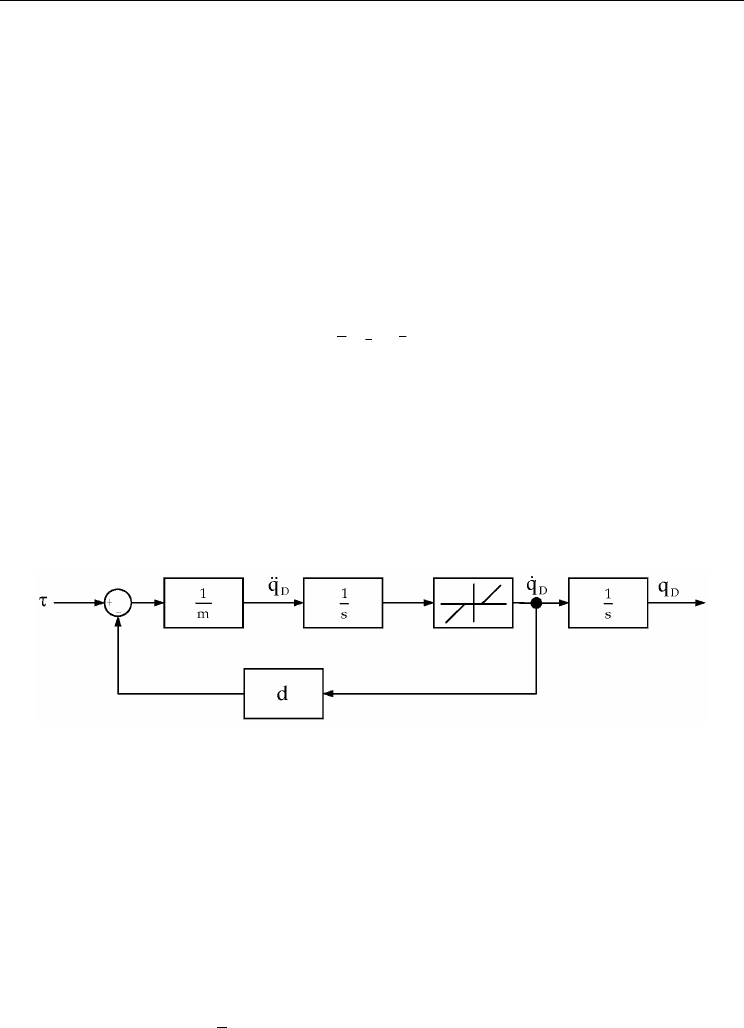
Human-Robot Interaction
462
In spite of some differences the time series of measured and estimated interaction joint
torques match quite well. It may thus be possible to use the desired values of the motor
currents for robot force control or force based human robot interaction.
4.2 Human robot interaction based on motor currents
After estimating the interaction torques from the motor currents that values can be used for
force guidance without F/T sensor. Because the forces and torques caused be the operator
and estimated by the algorithm developed in the previous section are present in joint space,
it will be convenient to perform the force guidance in joint space, too. Otherwise the
interaction joint torques ought to be transformed into coressponding Cartesian
forces/torques using the inverse of the Jacobian matrix which will result in problems in and
near singularities.
τ⋅=
−T
JF
(21)
Another point why the Cartesian space approach may be unfavourable is the following:
Unlike to the robot equipped with F/T wrist sensor the operator is able to move the motor
current guided robot by pushing or pulling the manipulator arm at arbitrary location.
Transforming such interaction forces into Cartesian forces/torques of robot tool frame the
resulting robot motion may become anomalous. It is therefore proposed to perform human
robot interaction based on motor currents in joint space.
Figure 13. Mass damper desired behaviour with additionally dead zone nonlinearity
Because the estimated interaction torques differ somewhat from the measured values which
are more accurate it is extremely important to implement the dead zone nonlinearity in the
desired impedance behaviour. Besides its integration into the branch of the estimated joint
torque very convenient place is also the branch of the desired joint velocity. Than the desired
impedance behaviour based on the suggested mass damper system results in the signal flow
diagram shown in Fig. 13. The dead zone nonlinearity prevents undesired motions of the robot
caused by inaccurate estimation or measurement of the interaction forces and/or torques. A
disadvantage of the implemented nonlinearity is that it distorts the specified parameters of the
desired impedance behaviour, e.g. the value of damping will be increased.
For validation of force guidance without F/T sensor the pertaining algorithm was
implemented in the WinDDC-Real-Time-Controller. Robot MANUTEC r3 was located at
starting position given by q
=[0 0 90° 0 0 0]
T
. Force guidance was activated for all joints. The
operator acts on the manipulator arm to guide it throughout the work space. Fig. 14 shows

Possibilities of force based interaction with robot manipulators
463
the estimated interaction joint torques caused by the operator. From these values the desired
joint angles are calculated using the desired behaviour proposed in Fig. 13. The desired joint
angles are connected to the joint position control loops which consist of simple proportional
controllers with additional feed forward control of the joint velocities. The plots of the joint
angle values as a result of robot force guidance based on motor currents are shown in Fig.
15. The diagram is subdivided into parts numbered by lower case letters. These letters can
be found again in Fig. 16 where some snapshots of robot posture during force guidance are
presented. It can be seen that it is possible to guide the robot throughout the workspace by
the operator without F/T sensor. During the experiment also some singularities were
crossed without any problem.
Figure 14. Estimated interaction joint torques during force guidance
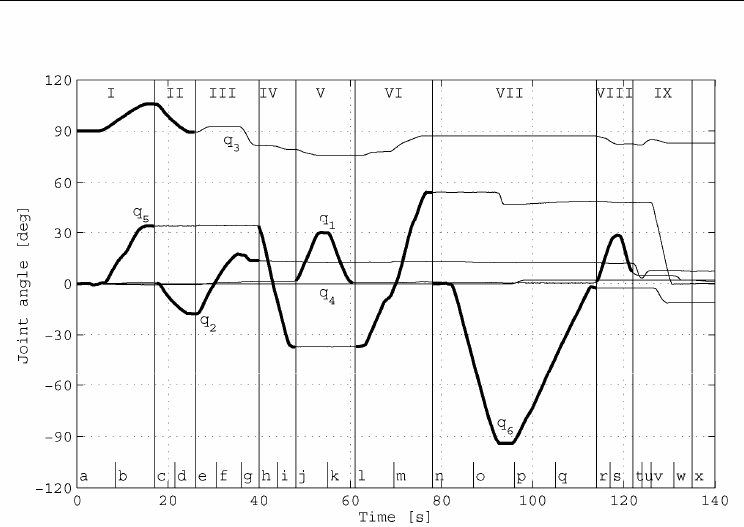
Human-Robot Interaction
464
Figure 15. Joint angles during sensorless force guidance
4.3 Sensorless approaches to force guidance with industrial robot controllers
The just proposed approach to force based human robot interaction without F/T sensor
requires the access to the actual or desired values of the joint motor currents. Using
industrial robot controllers its functionality is often restricted to industrial applications like
handling or assembly. Robot programmer can not expect that in the particular programming
language any command is available which returns the motor currents or the joint torques.
Nevertheless, some industrial robot controllers provide this functionality. An example is the
RSI programming mode of the KUKA robot controller, already mentioned in the previous
section, which enables sensor guided robot motion in real time. One special RSI object
provides the values of the motor currents. They may be integrated into the corresponding
controller structure consisting of RSI objects (Winkler & Suchý, 2006a).
Another functionality is the so called soft servo. It is available in several robot controllers,
possibly under different name. Using the soft servo feature the stiffness of particular joints
can be reduced. Commonly it is implemented by limiting the output signal of the velocity
control loop in the joint position cascade controller. The soft servo is useful in some
industrial applications to reduce high contact forces. However, soft servo is not favourable
in force based human robot interaction. If the robot is moved and the motion is followed by
change of the gravitational torques acting on the joints the robot can become unstable.
Another disadvantage is that it is not possible to define the desired impedance behaviour. It
is caused by robot mechanics with open joint brakes and without motor power. So it may be
difficult to move a heavy payload robot by human force interaction.
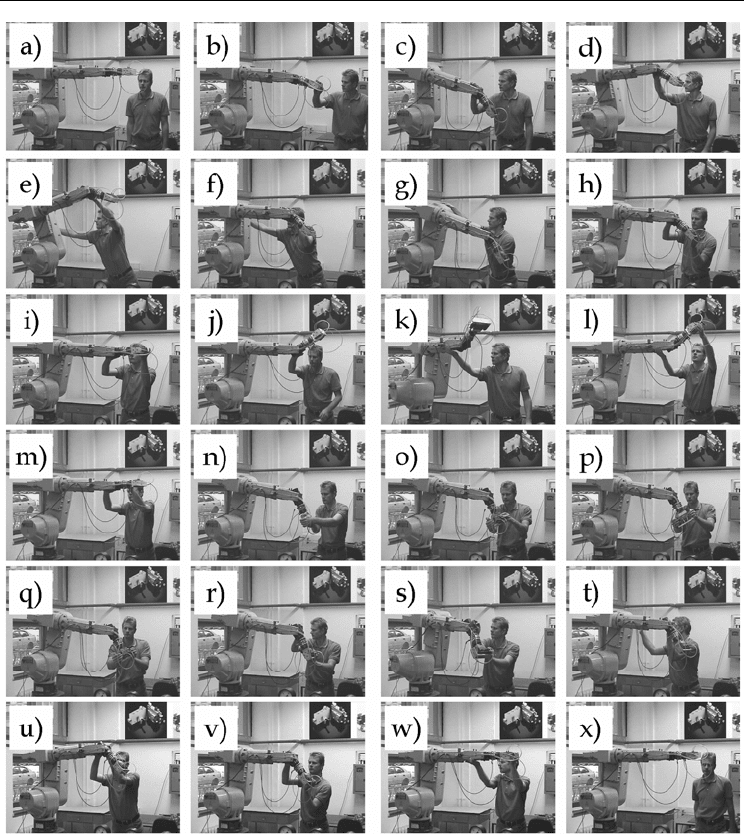
Possibilities of force based interaction with robot manipulators
465
Figure 16. Snapshots of robot posture during sensorless force guidance
5. Robot teleoperation with force feedback
One special kind of human robot interaction may be developed in robotic teleoperation.
Teleoperation means the remote control of a robot manipulator by an operator. Fields of
applications for such a system are in hazardous environments like nuclear power plants or
chemical plants. Robot teleoperation becomes more and more important also in medicine or
astronautics. The basic idea is to remotely control the slave robot by master which can be
implemented as control panel, joystick, phantom robot or haptic interface. Operator on the
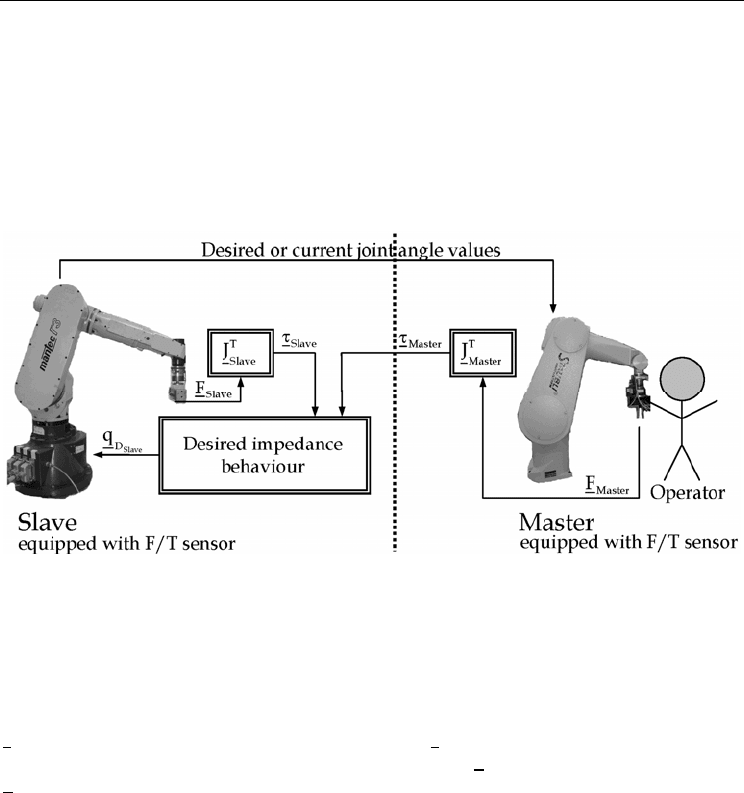
Human-Robot Interaction
466
master side may be supported by audio-visual or haptic feedback from the slave side. If the
robot is controlled by the so called haptic interface the operator gets a feedback of the
contact forces/torques of the slave robot. The force feedback may be essential for some
tasks.
Many structures of teleoperation systems were already published (Hirzinger et al., 1997;
Sheridan, 1989; Sheridan, 1995). For the realization of a teleoperation system with force
feedback it is also possible to use a force guided master robot instead of haptic interface.
One proposed configuration is shown in Fig. 17.
Figure 17. Proposal of a teleoperation system controlled in joint space by a force guided
master robot
Both robots are equipped with F/T wrist sensors. On the other side, joint torque sensors or
the schemes for estimation of the interaction or contact forces using the motor currents are
also conceivable. The interaction forces of the master robot caused by the operator are
transformed into joint space according to Eq. (5). The interaction joint torques are
transmitted to the slave robot controller, e.g. by Ethernet connection. From the values of
τ
Master
and the contact joint torques of the slave robot τ
Slave
the desired impedance behaviour
computes the desired joint angle values of the slave robot q
DSlave
. The components of vector
q
DSlave
or the current joint positions are sent to the controller of the master robot where the
corresponding motion will to be performed. The joint angle values have to be contingently
adjusted to the particular master robot.
Very important for the stability of a teleoperation system is the time delay of data
transmission. A lot of publications are dealing with this problem (Sheridan, 1989; Sheridan,
1995). One approach is based on predictive algorithms.
6. Conclusion
In this paper some possibilities and features of force based human robot interaction were
presented. First, it was assumed that the robot manipulator is equipped with a six
component force/torque wrist sensor to measure the interaction forces and torques caused
by an operator. He or she tries to guide the robot throughout the work space by taking the

Possibilities of force based interaction with robot manipulators
467
gripper and pushing or pulling it. It was distinguished between the task and the joint space
approach to force guidance which resulted in different behaviour with respect to the robot
motion. This was shown in particular with the kinematics of the Planar Two Link
Manipulator.
For the specification of the robot dynamics during force guidance the desired impedance
behaviour was introduced. Using force guidance for the comfortable teach-in, e.g., the
behaviour of a simple mass damper system was proposed as the basis for the desired
impedance behaviour. Of course, for the implementation of these ideas in the robot
controller additional features had to be realized. Besides some standard features like robot
velocity limits and the joint limit stops a very extensive functionality is the intuitive collision
avoidance. It is based on the force potential fields around obstacles generated by virtual
charges. For this purpose the corresponding algorithm was described. However, some more
research activities seem to be necessary on this field. Apart from the desired impedance
behaviour the dynamic behaviour of the robot manipulator together with its controller is
important for the stability of the whole robot system for force based human robot
interaction. Therefore, some common robot systems were regarded with respect to their
possibilities of motion generation. This aspect is also crucial for robot force control in
general and seems to be important for further research as only few robot controllers admit
to set the desired joint torques and/or forces by programmer. On the other side this
property is assumed by most of the published approaches to robot force control.
Because a six component force/torque sensor may be very expensive, an alternative
approach for the determination of the contact forces/torques between robot and
environment was suggested. It is based on the motor currents of the joint drives. From these
values provided by the joint power amplifiers it was possible to estimate the forces and
torques acting on the whole manipulator arm. The algorithm is especially suitable for low
payload robots where the relationship between interaction and gravitational forces is high.
In particular the estimation of frictional joint torques from the motor currents, which is very
difficult, has to be investigated in more detail. Besides application of this approach to force
based human robot interaction it may be also used in standard robot force control.
One special application of force based human robot interaction is robot teleoperation with
force feedback. It may be e.g. realized with the joint space approach to force guidance. In
this paper the basic structure of a teleoperation system is proposed. It consists of a slave and
a master robot each equipped with force/torque sensor. The force guided master robot
represents the input device for the operator and the slave robot works in the target
environment.
7. References
Angeles, J. (2003). Fundamentals of Robotic Mechanical Systems, Springer, ISBN 0-387-95368-X,
New York
Choset, H.; Lynch, K.; Hutchinson, S.; Kantor, G.; Burgard, W; Kavraki, L. & Thrun, S.
(2005).
Principles of Robot Motion, MIT Press, ISBN 0-262-03327-5, United States
Craig, J. J. (2005).
Introduction to Robotics Mechanics and Control, Pearson Prentice Hall, ISBN
0-13-123629-6, United States
Deutsches Institut für Normung (1993).
Industrieroboter – Sicherheit, DIN EN 775 (ISO 10218)
Gorinevsky, D. M.; Formalsky, A. M. & Schneider, A. Y. (1997).
Force Control of Robotic
Systems, CRC Press, ISBN 0-8493-2671-0, United States

Human-Robot Interaction
468
Hirzinger, G. & Heindl, J. (1986). Device for programming movements of robot manipulators,
US-Patent 4,589,810
Hirzinger, G.; Arbter, K.; Brunner, B.; Koeppe, R.; Landzettel, K. & Vogel, J. (1997).
Telerobotic control and human robot-interaction,
Proc. of IEEE International
Conference on Robotics and Automation, Albuquerque, United States, April 1997,
McKerrow, P. J. (1995).
Introduction to Robotics, Addison-Wesley, ISBN 0-201-18240-8
Sciavicco, L. & Siciliano, B. (2004).
Modelling and Control of Robot Manipulators, Springer,
ISBN 1-85233-221-2, London
Sheridan, T. B. (1989). Telerobotics,
Automatica, Vol. 25, No. 4, pp. 487-507
Sheridan, T. B. (1995). Teleoperation, Telerobotics and Telepresence: A Progress Report,
Control Eng. Practice, Vol. 3, No. 2, pp. 205-214
Som, F. (2004). Sichere Robotersteuerung für einen personensicheren Betrieb ohne trennende
Schutzeinrichtungen, In:
VDI Berichte 1841, pp. 745-754, VDI Verlag, ISBN 3-18-
091841-1, Düsseldorf
Stadler, W. (1995).
Analytical Robotics and Mechatronics, McGraw-Hill, ISBN 0-07-060608-0,
United States
Türk, S. & Otter, M. (1987). Das DFVLR Modell Nr. 1 des Industrieroboters Manutec r3,
Robotersysteme, Vol. 3, pp. 101-106
Winkler, A. & Suchý, J. (2005). Novel Joint Space Force Guidance Algorithm with
Laboratory Robot System,
Proc. of 16th IFAC World Congress, Prague, Czech
Republic, July 2005
Winkler, A. & Suchý, J. (2006a). An Approach to Compliant Motion of an Industrial
Manipulator,
Proc. of 8
th
International IFAC Symposium on Robot Control, Bologna,
Italy, September 2006
Winkler, A. & Suchý, J. (2006b). Force-guided motions of a 6-d.o.f industrial robot with a
joint space approach,
Advanced Robotics, Vol. 20, No. 9, pp. 1067-1084
Zeng, G. & Hemami, A. (1997). An overview of robot force control.
Robotica, Vol. 15, pp. 473-
482
26
Playing Games with Robots – A Method for
Evaluating Human-Robot Interaction
Min Xin and Ehud Sharlin
University of Calgary
Canada
1. Introduction
Some of the acute technological challenges of the near future may relate to the coexistence of
intelligent robots and humans. Robotic technology is quickly advancing and some
believe that this rapid progress will have a huge effect on people and societies in the
coming few decades (Moravec, 1999). Norman (Norman, 2004) suggests that we are
already surrounded by simple robots, such as computerised dishwashers and cars.
However, these devices still lack the capability and intelligence required for us to
recognize them as “robots”. Forlizzi and Disalvo (Forlizzi & Disalvo, 2006) demonstrated
that even the introduction of the simple, popular and almost ubiquitous Roomba robotic
vacuum cleaner had raised important human-robot interaction (HRI) questions, and
changed social structures and patterns within domestic environments. Following, it is
crucial that we understand the various issues and problems surrounding interaction with
robots and be able to design effective interfaces that will allow us to work collaboratively
with robotic interfaces.
Current designers of HRI paradigms no longer see robots as fully-controlled subordinates
but rather as colleagues of sort, with a spectrum of social and emotional abilities (see for
example (Breazeal, 2002)). It is logical that humans will find future autonomous robots
more effective and collaborative if the robots act according to behavioural patterns that
humans can easily recognize and relate to. Obviously, the challenge of creating robotic
interfaces that will be fully aware of rich social settings, roles and proper action is
enormous. However, future social robots may be integrated into everyday life tasks if
they successfully exploit the human inclination to anthropomorphize animated
phenomena and objects (Moravec, 1999), in a sense providing a task-limited illusion of
social awareness and supporting a sociably accepted set of actions. Robots can use
various methods in order to enhance their social acceptance skills, from the use of natural
language, human-like or animal-like appearance and affordances, to animated movement
and even cartoon art expression (Young et al., 2007).
How can we rapidly and efficiently design, implement and test sociable and other human-
robot interfaces? The straightforward approach would be to design, implement and test
for the actual, fully realistic robotic task. However, with robots being used for tasks such
as space exploration, urban search and rescue, and battlefield support, developers may
find themselves unable to be engaged in meaningful sociable HRI design in academic and

Human-Robot Interaction
470
other laboratory settings. Many of the sociable HRI design dilemmas can be answered
only after extensive testing and carefully controlled repetitive experiments. Since current
robots are often engaged in difficult, dangerous and dirty (DDD) tasks, designing and
testing sociable HRI paradigms can be a challenge which will arguably have to wait till
sociable robotic platforms are more common and affordable.
In this paper we propose a meaningful and controlled HRI experimental testbed approach
based on collaborative gameplay between robots and humans. We argue that our testbed
approach supports rapid design, implementation and testing of various meaningful
sociable robotic interaction techniques in relatively simple settings. How can we evaluate
the validity of our suggested testbed? Similar to the psychology concept of transfer of
cognitive skill (Singley, 1989), we consider the transfer of robotic skills from the testbed to
real life. Humans can transfer cognitive knowledge from one experience to the other in
various ways, with transfer being categorized as being either positive or negative; with the
original experience enhancing or hindering the target experience, respectively. Similarly,
we can assess the quality of an HRI testbed through its ability to transfer a set of robotic
abilities from one experience to the other. A “good” testbed will be able to provide
positive transfer of robotic abilities to its target application and inform of right answers to
design dilemmas and challenges. On the other hand, a testbed can provide negative
transfer of robotic abilities, pointing to design decisions that appear proper in
experimental settings but fail once tested in real settings.
In the next sections we discuss the notion of human gameplay and its mappings to social
interactions and tasks. We discuss the benefits and limitations of using games as HRI
testbeds and suggest a set of simple heuristics for designing “good” HRI game-based
testbeds which we believe will provide positive transfer to real-life settings. We then
review several related efforts of using gameplay in HRI and attempt to analyse them
using our suggested heuristics. Finally, we reflect on our own experience of designing,
implementing and evaluating an HRI testbed based on a board game called Sheep and
Wolves.
2. Gameplay and HRI
In order to design an effective testbed for human-robot interaction, we look to one of the
most frequent human activities that have persisted through the development of
civilization: playing games. Games are a staple of everyday life. Whether it is battling
through a few games of Mario Kart, participating in a game of Bingo, or dressing up a
Barbie doll, we play regardless of age or gender. Although many do not often consider
playing games as an essential part of life, it is never the less a critical factor in human
development. Through playing games, we interact with our world, communicate with
other humans, and even explore brand new environments and experiences. Games are
ripe with opportunities for interaction. What if we involve robots within our games?
How will we design them to play with humans? What will we learn about human-robot
interaction by playing games with robots? These questions motivate our exploration for
using games as effective testbeds for evaluating human-robot interaction.
The goal of human-robot interaction is to investigate how to design robots for a variety of
applications such as search and rescue or performing domestic duties. Compared to the
other more important and practical applications, designing robots to play games seems
